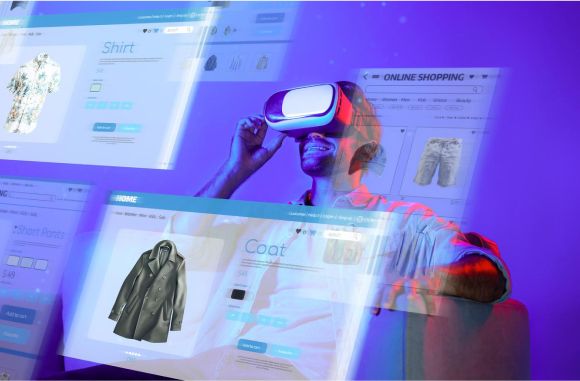Market Overview and Growth Trajectory
The generative AI revolution in retail and eCommerce represents one of the most significant technological transformations since the advent of online shopping itself. The global generative AI in retail market has experienced explosive growth, expanding from $741.38 million in 2024 to an estimated $1,015.68 million in 2025. Industry projections indicate this market will reach approximately $17.27 billion by 2034, representing a remarkable compound annual growth rate (CAGR) of 37%.
Fundamental shifts in consumer expectations and technological capabilities are driving this growth trajectory. Currently, 78% of enterprise retailers employ generative AI in at least one customer-facing application, with total spending on generative AI retail solutions reaching $18.7 billion in the past 12 months. Most significantly, small to mid-size retailers utilizing generative AI are experiencing 31% faster revenue growth compared to non-users.
Beyond Conversational Interfaces: The Expansion of GenAI Applications
Personalized Marketing and Hyper-Personalization
The most transformative application of generative AI in retail extends far beyond simple chatbot interactions into sophisticated personalization engines. Unlike traditional segmentation approaches, modern GenAI systems create individualized customer profiles by analyzing purchase history, browsing patterns, social media activity, and real-time behavioral signals.
Leading retailers are implementing hyper-personalization strategies that generate unique shopping experiences for each customer. For instance, AI systems can dynamically alter website layouts, product recommendations, and promotional content based on factors like local weather patterns, seasonal trends, and individual shopping preferences. This approach has proven highly effective, with retailers reporting up to 30% improvements in conversion rates and 50% reductions in customer acquisition costs.
Visual Merchandising and Product Design Innovation
Generative AI is revolutionizing product design and visual merchandising by analyzing market trends, consumer preferences, and sales data to create appealing product variations. Companies like Zara employ generative AI to create virtual fashion lines based on customer preferences and trending styles. This technology enables rapid prototyping and reduces the time-to-market for new products significantly.
In visual merchandising, AI systems can generate multiple design prototypes quickly, optimize store displays based on predicted customer behavior, and create photorealistic lifestyle images from basic product photos. Amazon’s AI-powered image generation tool, launched in late 2023, transforms basic product photos into realistic lifestyle images, improving advertising click-through rates by up to 40%.
Content Creation and Automation at Scale
One of the most immediate applications of generative AI is automating content creation across multiple channels. eBay’s AI-driven tool can generate comprehensive product listings from minimal input or just a photo, saving sellers significant time while ensuring accuracy and consistency. This automation extends to marketing communications, where AI can create personalized messages, email campaigns, and promotional content tailored to individual customer segments.
The economic impact is substantial: retailers using generative AI for content creation report 47% savings in content creation costs and 25% improvements in organic search rankings. This efficiency allows human creative teams to focus on strategic initiatives while AI handles routine content production.
Virtual Try-On and Augmented Reality Experiences
Virtual try-on technology powered by generative AI represents a significant advancement beyond traditional e-commerce interfaces. Companies like Sephora use facial recognition and AR to allow customers to experiment with makeup products virtually, while Google has introduced virtual try-on features for women’s clothing across multiple brands.
The technology addresses a fundamental challenge in online shopping: the inability to physically interact with products before purchase. According to recent surveys, 44% of consumers have used virtual try-on features while shopping, with 69% making purchases either online or in-store as a result. This technology significantly reduces return rates while increasing customer confidence in online purchases.
Voice Commerce and Conversational Shopping
Voice commerce represents a paradigm shift toward more natural, intuitive shopping experiences. With 8.4 billion digital voice assistant units active worldwide in 2024, voice-enabled shopping is transforming how consumers discover and purchase products. Unlike traditional voice search that simply returns information, modern voice commerce facilitates complete transactions through natural language interactions.
Advanced voice commerce systems can understand context, maintain conversation history across multiple sessions, and provide personalized recommendations based on past purchases and preferences. This technology is particularly valuable for routine purchases, where consumers can reorder frequently bought items through simple voice commands.
AI-Powered Loss Prevention and Fraud Detection
Generative AI is enhancing retail security through sophisticated anomaly detection and behavioral analysis systems. These systems use computer vision and machine learning algorithms to identify suspicious activities in real-time, from unusual transaction patterns to potential theft behaviors.
Smart shelf technology equipped with weight sensors and computer vision can detect anomalies in product placement or removal, while RFID tags provide continuous item-level tracking. These systems trigger real-time alerts for security personnel, enabling proactive intervention before losses occur. The technology extends to point-of-sale fraud detection, where AI analyzes transaction patterns to identify potentially fraudulent activities.
Global Market Dynamics
North American Leadership
North America dominates the generative AI in retail market with a 43% global market share, driven by rapid technological advancement and significant investments by major technology companies like Microsoft, Google, and IBM. The United States alone is projected to grow from $225.50 million in 2024 to $5.53 billion by 2034.
The region’s success stems from several factors: robust cloud infrastructure, abundant venture capital, and retailers’ willingness to pilot cutting-edge technologies. Major retailers like Walmart have demonstrated tangible returns, with generative AI-driven merchandising contributing to a 4.8% revenue uplift.
Asia-Pacific: The Growth Engine
Asia-Pacific represents the fastest-growing region for AI in retail, expanding at an 18.9% CAGR through 2030. This growth is fueled by mobile-first consumers, government funding initiatives, and aggressive digital-native market entrants. In countries like China and India, social commerce platforms combine live video, conversational AI, and integrated payments to optimize impulse purchasing behaviors.
The region’s unique characteristics create ideal conditions for AI adoption: high mobile penetration, younger demographics comfortable with digital technologies, and government support for AI innovation initiatives.
The Indian Market: Unique Opportunities and Challenges
Market Landscape and Growth Potential
India’s retail AI market presents extraordinary growth potential, with EY India forecasting a 35-37% productivity boost in the retail sector within the next five years. This transformation is driven by India’s unique market characteristics: over 1.2 billion mobile connections, a burgeoning young population, and a rapidly digitizing retail ecosystem.
Indian e-commerce platforms are experiencing unprecedented AI adoption rates, with 80% of retailers planning to scale AI implementations in 2025. The market is expected to reach $300 billion by 2030, showcasing significant growth potential driven by increasing digital penetration and changing consumer behaviors.
Leading Indian Platforms and Implementations
Major Indian e-commerce platforms are implementing sophisticated AI solutions across their operations:
Flipkart has developed comprehensive AI capabilities including virtual assistants, multilingual AI support, and automated stock image generation. The platform uses AI for demand forecasting, inventory optimization, and personalized product recommendations.
Myntra employs generative AI and GPT-3.5 for query understanding and intent recognition, showing relevant product collections to users. The platform has particularly focused on penetrating Tier II and III cities through AI-powered vernacular language support.
Amazon India has implemented Rufus, an AI shopping assistant, alongside AI-powered product summaries and recommendation engines. The platform uses machine learning for enhanced virtual try-on experiences and predictive analytics.
The ONDC Revolution
The Open Network for Digital Commerce (ONDC) represents India’s ambitious attempt to democratize e-commerce through an open, interoperable platform. Since its inception, ONDC has registered 68 million transactions and onboarded over 570,000 sellers. The initiative aims to break the dominance of large e-commerce platforms and create opportunities for small and medium enterprises.
ONDC’s AI-driven architecture uses geographic information systems (GIS) and algorithmic analysis to provide unbiased product discovery, enabling smaller retailers to compete effectively with larger platforms. The system’s emphasis on local languages and regional preferences makes it particularly relevant for India’s diverse market.
Challenges and Barriers
Despite significant opportunities, Indian retailers face several challenges in AI adoption:
Infrastructure Limitations: Many retailers lack the technical infrastructure required for advanced AI implementations, including reliable internet connectivity and sophisticated data management systems.
Skill Shortage: There’s a significant gap in AI expertise, with skilled data scientists and machine learning engineers remaining expensive and difficult to recruit.
Data Quality Issues: Indian retailers often struggle with fragmented data across multiple languages, dialects, and regional variations, making it challenging to train effective AI models.
Investment Constraints: Small and medium businesses find it difficult to justify upfront AI investments, especially when return on investment isn’t immediately apparent.
Future Trends and Emerging Technologies
Agentic AI and Autonomous Shopping
The next evolution of retail AI involves agentic systems capable of autonomous decision-making and complex task execution. These systems can anticipate customer needs, understand contextual intent, and provide proactive recommendations without explicit user requests. McKinsey identifies agentic AI as a rapidly emerging trend that will fundamentally change how consumers interact with retail platforms.
Metaverse and Immersive Shopping Experiences
The convergence of generative AI with metaverse technologies is creating unprecedented opportunities for immersive retail experiences. Virtual reality shopping environments enable customers to interact with products in three-dimensional spaces, try on virtual clothing, and experience products in simulated real-world contexts.
These experiences go beyond traditional e-commerce by creating social shopping environments where customers can interact with friends, attend virtual events, and experience brands in entirely new ways. The technology promises to bridge the gap between online convenience and in-store experiential shopping.
Multimodal AI Integration
Future retail AI systems will seamlessly integrate text, voice, image, and video inputs to create more natural and intuitive shopping experiences. This multimodal approach enables customers to search for products using combinations of text descriptions, voice commands, and visual references, making product discovery more efficient and accurate.
Strategic Implications for Retailers
Implementation Roadmap
Successful generative AI implementation requires a structured approach focusing on high-impact, low-complexity use cases initially. Retailers should prioritize applications that deliver immediate efficiency gains while building capabilities for more sophisticated implementations.
Key implementation steps include:
- Data Infrastructure Development: Establishing robust data collection and management systems
- Pilot Program Execution: Testing AI applications in controlled environments with measurable outcomes
- Cross-functional Integration: Ensuring AI systems integrate seamlessly with existing retail operations
- Talent Acquisition and Training: Building internal AI expertise and training existing staff
- Scalable Platform Development: Creating systems that can expand across multiple use cases and channels
Competitive Differentiation
Retailers that successfully implement generative AI beyond basic chatbot functionality gain significant competitive advantages through enhanced customer experiences, operational efficiency, and market responsiveness. The technology enables smaller retailers to compete with larger platforms by providing sophisticated personalization and automation capabilities previously available only to major corporations.
The transformation extends beyond individual applications to fundamental changes in how retailers operate, make decisions, and interact with customers. As generative AI continues evolving, its impact on retail and e-commerce will only intensify, making early adoption and strategic implementation critical for long-term success.
The retail industry stands at a pivotal moment where generative AI is moving far beyond simple conversational interfaces to become a fundamental driver of business transformation. From hyper-personalized shopping experiences to autonomous inventory management and immersive virtual try-on technologies, AI is reshaping every aspect of retail operations. The substantial market growth projections and proven ROI metrics demonstrate that this technology shift represents not just an opportunity but a competitive necessity for retailers worldwide, particularly in dynamic markets like India where digital transformation is accelerating at unprecedented rates.



 Services
Services



